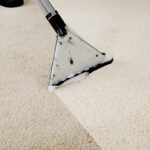Couch cleaning is a task that is necessary to maintain a couch’s appearance and to prolong its life so that finding the money needed to replace them does not become a regular occurrence. Unlike cleaning some items, where the material being cleaned rarely changes, such as the glass in windows, couches can be made from a variety of materials which each require different methods of cleaning.
For example, couches can be made using a huge range of different fabrics, such as cotton, wool, polyester, silk, and nylon, to name but a few, and each of them should be cleaned differently. In addition, we also have suede and leather, and given that leather is a hugely popular material for couches, we thought it would be useful to focus on the “dos and don’ts” of cleaning leather couches.
The “Dos” Of Cleaning A Leather Couch
- Follow The Care Label Instructions: A misconception about leather couches is that the leathers are all the same and can be cleaned the same way. This is false as there are several leather types and grades, and therefore you must read the care label for your leather couch to check the advice on cleaning the leather type it is made from.
- Regularly Vacuum: Another misconception about leather is that it does not need vacuuming as much as fabric. Again, not true as crumbs, grit, and dirt all need to be removed every bit as much from a leather couch using a vacuum cleaner regularly as a fabric couch.
- Use Proven Leather Cleaning Products: Although family, friends, and even those online will extol the virtues of their leather cleaning recipes and potions, you should avoid them. Instead, use only branded leather cleaning products which are proven to be safe for leather couches and are known to be effective at cleaning them.
- Test Cleaning Solutions Before Applying Them: Even if you have read the care label, and the cleaning product you are about to use is reputable, add to your peace of mind by testing the product on a small area of your couch just to be 100% certain it is safe. Ideally, test at the bottom corner of the back of the couch, which is usually hidden from view.
- Apply Leather Conditioner: Although more to do with maintaining your leather couch than cleaning it, this is important enough to include here. Using a leather conditioner will keep your leather healthy, therefore prolonging its lifespan and complimenting your efforts to clean your leather couch.
The “Don’ts” Of Cleaning A Leather Couch
- Use Excessive Amounts Of Water: Whilst leather is more able to withstand liquids than fabric, this should not be a green light to soak it with water when cleaning. This can cause watermarks to form, plus as leather is porous, excess water can penetrate it, causing additional damage.
- Apply Harsh And Untested Chemicals: Although you might come across leather cleaners that seem to be much cheaper than others, think about why they are cheaper. They are often simply a cocktail of harsh chemicals, many of which could do untold damage to your leather couch, so avoid them regardless of their low prices.
- Scrub Using Abrasive Materials: You may be tempted to scrub your leather couch to remove marks and stains due to the leather being tougher than most fabrics, but do not be. Scrubbing with abrasive materials can scratch the leather or, worse, remove its outer coating to leave visible bare patches of leather.
- Ignore Spillages: We have already mentioned leather is porous, and that is why our final “don’t” is ignoring spills. Even if left for a few seconds, liquid can penetrate leather which not only compromises its durability but can leave a permanent stain that needs to be removed professionally to restore the leather’s appearance.





